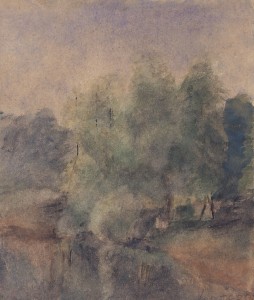V. N. Chekrygin had a significantly greater influence on the small group of students that, along with Koroteev, included G. V. Kostyukhin, V. I. Gubin, S. S. Grib and G. V. Sashenkov than on his comrades in Makovets. Makovets was a union of established masters, but in the opinion of V.N. Chekrygin, a great mystic and visionary of the avant-garde era, they were not close enough or seemed extravagant beyond measure. To a great extent they were divided, or, at any rate, it was probably only L. F. Zhegin who paid him a great amount of attention; Zhegin sincerely loved him and valued above much else the amazing talents of this youthful artist who remained forever young. In 1922, V. N. Chekrygin passed away tragically at twenty five years of age.
L. F. Zhegin managed to imbue his students with his delight in the works of V. N. Chekrygin, whom he termed nothing less than a “genius youth”; he managed to teach them not only the methods of artistic mastery but also, first and foremost, an understanding of art as the spiritual path of the contemporary individual. When, in 1925, they completed their studies at the workshops, the group that had banded together around its teacher didn’t break up. After the effective end of Makovets’s activities in 1926, the group was joined by several former participants in the Union: T. B. Aleksandrova, P. P. Babichev, I. G. Nikolaevtsev and V. E. Pestel. Then the group took on the name Way of Painting and replaced Makovets in the distribution of power among the artistic associations of the twenties.
Koroteev’s connection with his mentors proved to be especially deep and was reflected in all of his work. Their attempt to search out art that would change the picture of the world, their vow to themselves for almost ascetic rigor and their demand for genuine, uncompromising work resonated with their guiding sense of life as a heartfelt break through conditionality, general norms and the promptings of common sense.
Landscapes, which, beginning in the Way of Painting period, occupied a central place in Koroteev’s work, call to mind one more fragment of text from “Our Prologue” which became truly programmatic for him:
“We do not sense nature as an environment; we feel it in that genuine condition that is revealed only with the help of deep, artistic understanding. Its creative manifestations are not a means for brightening our life: they belong to us collectively and uniformly, and we are distressed that there exist manifestations of nature that are, as it were, hidden from us. The task of our work is to merge nature together with its unconscious voices, which climb to the high realm of spiritual life, together with it, to create powerful, integrated, objective portrayals that synthesize these states of being.” [2] These words identify with stunning clarity the spirit of many of Koroteev’s works, both early and late in his career. He would address this task throughout his entire life.
____________________
[2] — Makovets. 1922-1926. Sbornik materialov po istorii obedineniya (Collection of Works on the History of the Association). Moscow, 1994- P. 56.



